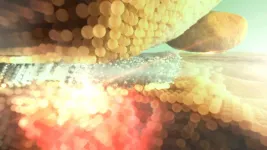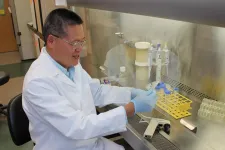Green light on gold atoms
2021-05-21
(Press-News.org) Because individual atoms or molecules are 100 to 1000 times smaller than the wavelength of visible light, it is notoriously difficult to collect information about their dynamics, especially when they are embedded within larger structures.
In an effort to circumvent this limitation, researchers are engineering metallic nano-antennas that concentrate light into a tiny volume to dramatically enhance any signal coming from the same nanoscale region. Nano-antennas are the backbone of nanoplasmonics, a field that is profoundly impacting biosensing, photochemistry, solar energy harvesting, and photonics.
Now, researchers at EPFL led by Professor Christophe Galland at the School of Basic Sciences have discovered that when shining green laser light on a gold nano-antenna, its intensity is locally enhanced to a point that it "knocks" gold atoms out of their equilibrium positions, all the time maintaining the integrity of the overall structure. The gold nano-antenna also amplifies the very faint light scattered by the newly formed atomic defects, making it visible to the naked eye.
This nanoscale dance of atoms can thus be observed as orange and red flashes of fluorescence, which are signatures of atoms undergoing rearrangements. "Such atomic scale phenomena would be difficult to observe in situ, even using highly sophisticated electron or X-ray microscopes, because the clusters of gold atoms emitting the flashes of light are buried inside a complex environment among billions of other atoms," says Galland.
The unexpected findings raise new questions about the exact microscopic mechanisms by which a weak continuous green light can put some gold atoms into motion. "Answering them will be key to bringing optical nano-antennas from the lab into the world of applications - and we are working on it," says Wen Chen, the study's first author.
INFORMATION:
Other contributors
Wuhan University
Max Planck-EPFL Laboratory for Molecular Nanoscience
Reference
Wen Chen, Philippe Roelli, Aqeel Ahmed, Sachin Verlekar, Huatian Hu, Karla Banjac, Magalí Lingenfelder, Tobias J. Kippenberg, Giulia Tagliabue, Christophe Galland. Intrinsic luminescence blinking from plasmonic nanojunctions. Nature Communications 21 May 2021. DOI: 10.1038/s41467-021-22679-y
[Attachments] See images for this press release:

ELSE PRESS RELEASES FROM THIS DATE:
2021-05-21
Research has shown that joining a gang is associated with increased criminal behavior. A new study examined whether the intermittent nature of gang membership affects offending. Researchers sought to determine whether the association with increased offending was a consistent attribute or, since people enter and exit and re-enter gangs, whether the intermittent nature of membership affected members' likelihood of offending. The study found that first-time membership was associated with increases in criminal behavior from when gang members were not in gangs, and that joining for a second ...
2021-05-21
The plant Aristolochia microstoma uses a unique trick: its flowers emit a fetid-musty scent that seems to mimic the smell of decomposing insects. Flies from the genus Megaselia (family Phoridae) likely get attracted to this smell while searching for insect corpses to mate over and lay their eggs in. When they enter a flower, they are imprisoned and first pollinate the female organs, before being covered with pollen by the male organs. The flower then releases them unharmed.
"Here we show that the flowers of A. microstoma emit an unusual mix of volatiles that includes alkylpyrazines, which are otherwise rarely produced by flowering plants. Our results suggest that this is the first known case of a flower that tricks pollinators by smelling like dead and rotting insects rather than vertebrate ...
2021-05-21
UK doctors have nothing to fear from the introduction of a central register listing money or benefits they receive in addition to their NHS salary, say experts today ahead of a public meeting on the issue hosted by the All-Party Parliamentary Group for First Do No Harm and The BMJ.
Last year the Independent Medicines and Medical Devices Safety Review, chaired by Baroness Julia Cumberlege, investigated harmful side effects caused by the hormone pregnancy test Primodos, the anti-epileptic drug sodium valproate, and pelvic mesh.
During the review, she heard from patients who were concerned that clinicians ...
2021-05-21
Within the next decade, the novel coronavirus responsible for COVID-19 could become little more than a nuisance, causing no more than common cold-like coughs and sniffles. That possible future is predicted by mathematical models that incorporate lessons learned from the current pandemic on how our body's immunity changes over time. Scientists at the University of Utah carried out the research, now published in the journal Viruses.
"This shows a possible future that has not yet been fully addressed," says Fred Adler, PhD, professor of mathematics and ...
2021-05-21
LA JOLLA, CA--Fast-spreading variants of the COVID-19-causing coronavirus, SARS-CoV-2, carry mutations that enable the virus to escape some of the immune response created naturally or by vaccination. A new study from scientists at Scripps Research, along with collaborators in Germany and the Netherlands, has revealed key details of how these escape mutations work.
The scientists, whose study appears in Science, used structural biology techniques to map at high resolution how important classes of neutralizing antibodies bind to the original pandemic ...
2021-05-20
Environmental quality is associated with advanced-stage prostate cancer at diagnosis, according to a new study by University of Illinois Chicago researchers.
Prostate cancer is up to 57% heritable, with the remainder attributed to environmental exposures. However, studies on those environmental factors and prostate cancer aggressiveness have previously been limited. For their study, "Association between environmental quality and prostate cancer at diagnosis," published in the journal Prostate Cancer and Prostatic Disease, researchers paired data from the environmental quality index, or EQI, and the Surveillance, ...
2021-05-20
Around the world and within the U.S., the percentage of people wearing masks during the Covid-19 pandemic has varied enormously. What explains this? A new study co-authored by an MIT faculty member finds that a public sense of "collectivism" clearly predicts mask usage, adding a cultural and psychological perspective to the issue.
The study uses a series of datasets about mask usage and public attitudes, along with well-established empirical indices of collectivism, to evaluate the impact of those cultural differences on this element of the pandemic response. ...
2021-05-20
Flies predict changes in their visual environment in order to execute evasive maneuvers, according to new research from the University of Chicago. This reliance on predictive information to guide behavior suggests that prediction may be a general feature of animal nervous systems in supporting quick behavioral changes. The study was published on May 20 in PLOS Computational Biology.
Animals use their sensory nervous systems to take in information about their environments and then carry out certain behaviors in response to what they detect. However, the nervous system takes time ...
2021-05-20
The immune system is a complex balancing act; if it overreacts or underreacts to foreign molecules, there can be serious health consequences.
For cancer patients, tumor progression is often accompanied by immunosuppression, meaning their bodies can't fight off pathogens the way they should. By contrast, for people with autoimmune diseases like type 1 diabetes, rheumatoid arthritis, and multiple sclerosis, their immune systems overreact and attack the body itself.
Both of these reactions are influenced by a series of molecular checkpoints found in both immune cells and cancer cells. In immune ...
2021-05-20
Oysters live and grow in saltwater. However, the saltiness of their habitat can change dramatically, especially where the mighty Mississippi River flows into the Gulf of Mexico. Louisiana oysters from the northern Gulf of Mexico may experience some of the lowest salinity in the world due to the influx of fresh water from the Mississippi River. In addition, increased rainfall and large-scale river diversions for coastal protection will bring more fresh water that does not bode well for the eastern oyster. New research led by Louisiana State University (LSU) alumna Joanna Griffiths from Portland, Oregon, and her faculty advisor ...
LAST 30 PRESS RELEASES:
[Press-News.org] Green light on gold atoms




